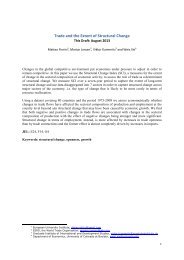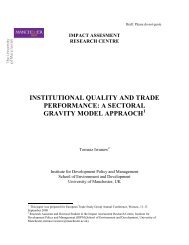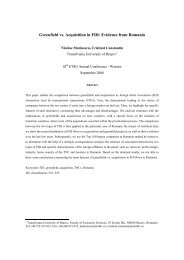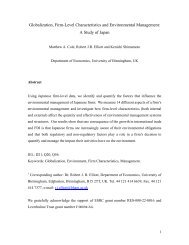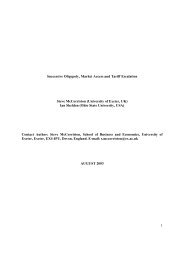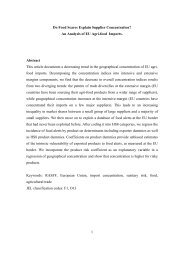Regional integration and the other determinants of North-South ...
Regional integration and the other determinants of North-South ...
Regional integration and the other determinants of North-South ...
You also want an ePaper? Increase the reach of your titles
YUMPU automatically turns print PDFs into web optimized ePapers that Google loves.
associated with a higher sensitivity <strong>of</strong> industrial location to both market <strong>and</strong> supply access<br />
(table 4.5).<br />
[Table 4.3]<br />
The signs <strong>of</strong> <strong>the</strong> variable’s (low_tech_i) coefficients in table 4.3, 4.4 <strong>and</strong> 4.5 confirm<br />
that low-technology industries are <strong>the</strong> most geographically concentrated industries in <strong>the</strong><br />
sample. However, <strong>the</strong> location <strong>of</strong> <strong>the</strong>se industries is much more significant in Sou<strong>the</strong>rn<br />
countries (see table 4.4) <strong>and</strong> higher during <strong>the</strong> most recent period (see table 4.5). These results<br />
confirm our descriptive analysis (section 2), <strong>the</strong> geographical concentration increases in <strong>the</strong><br />
euro-Mediterranean area <strong>and</strong> this concentration is higher in low-technology industries which<br />
are mainly located in <strong>the</strong> “<strong>South</strong>”.<br />
The different sample estimations highlight some divergences concerning <strong>the</strong> impact <strong>of</strong><br />
international openness on industries’ geographic distribution. Considering <strong>the</strong> sample as a<br />
whole (table 4.3), <strong>the</strong> coefficients appear positive but not always significant. In <strong>the</strong> subsample<br />
estimations (table 4.4), international openness has a negative <strong>and</strong> significant impact on<br />
industrial location in <strong>the</strong> “<strong>North</strong>” whereas it has <strong>the</strong> opposite impact on industrial location in<br />
new member states <strong>and</strong> Mediterranean countries. As we have shown in section 2., industrial<br />
production is less <strong>and</strong> less important in Westerns European countries whereas this production<br />
still constitutes an important part <strong>of</strong> NMC <strong>and</strong> MC’ production. Due to international<br />
competition, industries (especially low-technology industries) chose to locate in countries<br />
with lower production costs. Thus, in an integrated “<strong>North</strong>/<strong>South</strong>” area, international<br />
openness could generate <strong>the</strong> relocation <strong>of</strong> industrial production from Nor<strong>the</strong>rn countries to<br />
Sou<strong>the</strong>rn countries. These results also conform to <strong>the</strong> literature <strong>of</strong> regional <strong>integration</strong>. In<br />
addition, <strong>the</strong> impact <strong>of</strong> international openness on geographic concentration becomes positive<br />
<strong>and</strong> significant in <strong>the</strong> second sub-period <strong>of</strong> <strong>the</strong> sample (table 4.5)<br />
[Table 4.4]<br />
Finally, we can note that <strong>the</strong> signs <strong>of</strong> o<strong>the</strong>r variables keep <strong>the</strong> same whatever <strong>the</strong> sample<br />
considered. Proxies on <strong>the</strong> quality <strong>of</strong> business environment (time_bus_ct0) have <strong>the</strong> expected sign but are not always significant 63 when we<br />
consider <strong>the</strong> sample as a whole. However, <strong>the</strong> quality <strong>of</strong> business environment has a<br />
significant impact when we estimate <strong>the</strong> equation by regions (table 4.4). The size <strong>of</strong> industries<br />
is positively related to industrial geographic concentration (Firms>0).<br />
[Table 4.5]<br />
5. Conclusion<br />
The descriptive part <strong>of</strong> <strong>the</strong> article reveals <strong>the</strong> increase <strong>of</strong> geographic concentration <strong>and</strong><br />
specialization in <strong>the</strong> euro-Mediterranean area over <strong>the</strong> period 1990-2003. Sou<strong>the</strong>rn countries<br />
are more specialized than o<strong>the</strong>rs <strong>and</strong> low-technology industries appear also more concentrated<br />
than o<strong>the</strong>r industries. Thus, <strong>the</strong> aim <strong>of</strong> this article was to propose a comprehensive analysis on<br />
<strong>the</strong> distribution <strong>of</strong> industries in a sample <strong>of</strong> countries belonging to <strong>the</strong> euro-Mediterranean<br />
area. Our work was particularly concerned with proposing <strong>the</strong> appropriate way to evaluate <strong>the</strong><br />
63 Note that <strong>the</strong> variable <strong>of</strong> road density has been excluded in sub-sample regressions as <strong>the</strong> coefficients are<br />
never significant.<br />
21



